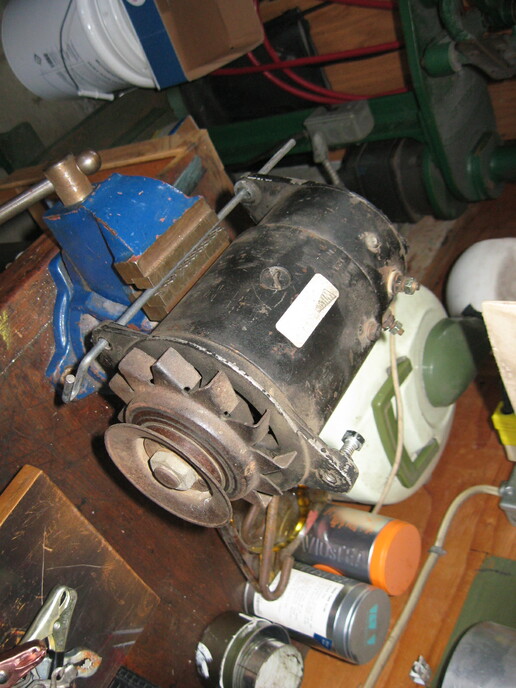Crazy Horse
Well-known Member
I have a 6 volt generator here, photo below. I think it's a Delco (someone might verify that) but there is no ID on it, the manufacturer's tag is gone but there is a rebuilder's tag on it with some meaningless numbers but it does say 6V. It was on a '45 Massey Harris 101 junior but it is definitely NOT a 3rd brush generator (that would use a light switch charge control and one relay cutout like those had originally). This one came from maybe an auto application, I guess it doesn't matter.
When I had it on the tractor and all wired up (like when I got it) and the tractor running, it did not show a charge at the ammeter or at the battery terminals. I did a 'motoring' bench test yesterday and the generator does motor, the pulley turns in a clockwise direction viewing from the pulley end (see the photo), the same direction the pulley would turn when rotated by the tractor's V-belt when running.
The generator has two internal brushes at the far end and has the expected field (F) and armature (A) terminals. It has a 3-tab regulator (with three coil towers inside). One is tagged B (the generator cutout relay circuit) and it hooks up to the ammeter. The other two are marked F (to field F on the generator) and G (to armature A on the generator). Those would be for voltage and current control from what I read, I'm not sure which tower controls the volts or amps.
So first question ...... does the motoring test indicate (or maybe even guarantee) that the generator 'should be' working when hooked up and driven by the engine?
Second question ....... I have read where there are two types of 3-tab regulators, type A and type B. This is where I become clueless, I suspect maybe that the wrong type of regulator might be on it, or maybe it has the correct regulator but it just isn't working properly. The regulator has 6V painted on the cover by someone.
Any suggestions for me without getting too complicated? Like do I have the correct voltage regulator (even if it might not be working correctly)? Or how do I tell type A from type B without going back to school and which one should match up to this generator?

When I had it on the tractor and all wired up (like when I got it) and the tractor running, it did not show a charge at the ammeter or at the battery terminals. I did a 'motoring' bench test yesterday and the generator does motor, the pulley turns in a clockwise direction viewing from the pulley end (see the photo), the same direction the pulley would turn when rotated by the tractor's V-belt when running.
The generator has two internal brushes at the far end and has the expected field (F) and armature (A) terminals. It has a 3-tab regulator (with three coil towers inside). One is tagged B (the generator cutout relay circuit) and it hooks up to the ammeter. The other two are marked F (to field F on the generator) and G (to armature A on the generator). Those would be for voltage and current control from what I read, I'm not sure which tower controls the volts or amps.
So first question ...... does the motoring test indicate (or maybe even guarantee) that the generator 'should be' working when hooked up and driven by the engine?
Second question ....... I have read where there are two types of 3-tab regulators, type A and type B. This is where I become clueless, I suspect maybe that the wrong type of regulator might be on it, or maybe it has the correct regulator but it just isn't working properly. The regulator has 6V painted on the cover by someone.
Any suggestions for me without getting too complicated? Like do I have the correct voltage regulator (even if it might not be working correctly)? Or how do I tell type A from type B without going back to school and which one should match up to this generator?


